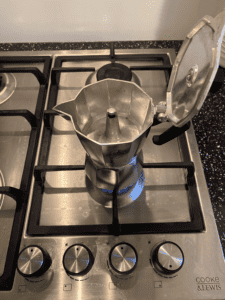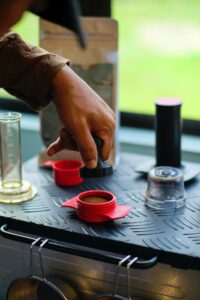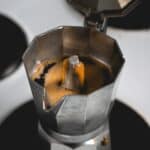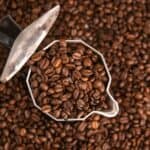Don’t Tamp Your Moka Pot, It Could Explode!

Whilst tamping is an essential part of making top notch espresso, the same cannot be said for Moka pot brewing. In fact, tamping your humble Moka pot could lead to excess pressure build up, under extracted coffee and even an explosion!
Here, I will break down why tamping might be a great idea for your espresso machine portafilter, it is certainly not a good idea when you are using your Moka pot.
What is a Moka Pot?
A moka pot is a small coffee brewing device that sits on a stovetop and uses the heat to push pressurized, boiling water through ground coffee. This results in a strong, espresso-like coffee that is strong but requires less pressure to make.
The Moka pot uses pressure to force steam through coffee grounds, in a similar way to an espresso machine, Aeropress or percolator.
However, where an espresso machine uses gravity and a downwards flow of hot water to extract coffee from the beans, a Moka pot works in the opposite direction.
Water is added to the bottom chamber of the Moka pot, with fine to medium ground coffee placed in the filter basket which sits on top. Then, the coffee collection chamber is screwed on tightly and the whole thing is placed over a hot stovetop.
Moka pots are so popular due to how simple they are to use. Simply add hot water and ground coffee, screw on the lid and place on your stovetop for delicious, strong coffee in minutes.
Why You Shouldn’t Tamp Your Moka Pot

When you use a Moka pot you’ll notice that there is simply a predetermined size of filter basket that should be filled up to the top with medium to fine ground coffee.
Whilst it is a good idea to level this mound of coffee off with a knife, and perhaps distribute it evenly with a WDT coffee distribution tool to avoid any clumps forming, tamping is not recommended!
The mechanics of a Moka pot are quite different to those of an espresso machine or Aeropress, and so the preparation process should be treated differently too.
Now, let’s take a closer look at what could happen if you do decide to tamp your Moka pot.
Your Moka Pot Could Explode
If you decide to tamp the ground coffee in your Moka pot, excess pressure is likely to build up. This happens because the hot water and steam that is looking to be forced up through the grounds to extract the liquid coffee does not have quite enough pressure to push through the compacted grounds.
When the coffee is simply resting in the Moka pot’s filter basket, there is enough pressure from the hot water to produce strong liquid coffee. However, when you compact the grounds down through tamping, there is simply too much force required to break through the densely packed grounds.
Therefore, if your Moka pot isn’t screwed up tightly enough and there is excess pressure built up in the water chamber, your Mokapot could well explode!
So, if you are using a Moka pot and don’t want to end up with a homemade coffee fuelled bomb, please don’t tamp your grounds!
Not Enough Pressure Will Be Built Up
Conversely, if you tamp your Moka pot your water is sitting below the safety valve, you will simply blow off all that hot air when too much pressure builds up in the water chamber. This will result in no water actually passing through your coffee grounds, resulting in no delicious coffee in the collection chamber.
Your Coffee Will Be Under Extracted
If any water does manage to get through your compacted bed of coffee, it will likely be weak, underextracted and sour.
This is becuase when ground coffee is compacted too tightly, the steam will try to find the path of least resistance. This will result in small spurts of water forcing their way through tiny holes in the coffee bed, which will cause channelling.
The upshot of channelling is some tiny pockets of coffee get overextracted (becuase so much water is being forced through a very small surface area), whilst the rest of the bed hardly gets any extraction at all.
You’ll therefore end up with a bed of coffee that overall is underextracted, weak and sour, not what anyone wants from their Moka pot!
Your Moka Pot Could Leak
If you tamp the coffee grounds in your Moka pot, the most likely outcome will be a leak being sprung somewhere in the device. In an ideal world, this will come from the ssafety valve being opened due to the build up of excess pressure in the water chamber.
However, this is not always the case, espcailly if your Moka pot is poorly made or poorly maintained.
In this case, you could have water steaming out of the silicone gasket which is supposed to act as a seal. This could damage your Moka pot permenantly.
What You Should Do With Your Moka Pot?
Now I’ve covered why you shouldn’t tamp you Moka pot, let’s discuss some of the good habits you should get into when using one.
Use a Medium to Fine Grind Size
The first thing to note when using a Moka pot is the grind size.
This is one of the most underrated and often overlooked aspects of brewing coffee, particularly at home.
Moka pots use pressure to brew coffee in a relatively short space of time. Therefore, they need a relatively fine grind size to extract as much coffee out of the grounds as possible whilst not over extracting and making a bitter drink.
The grind size required for the best Moka pot results should sit between a medium (V60) and espresso powder. If in doubt, grind slightly coarser than you think and then dial in your grind size from there.
Check out this article for a full breakdown of the best grind size for Moka pot.
Pick Fresh Coffee Beans
Another tip to improve your Moka pot preparation is to use fresh coffee beans wherever possible. These will be tricky to find in your local supermarket, so your best bet is to try an independent coffee house, roastery or order them online.
The key when looking to pick up fresh coffee beans is to locate a ‘roasted on’ date on the packet. This gives you a much more accurate indication of how old the coffee beans are compared to a ‘use by date’.
Using fresh coffee beans will ensure your end product tastes as flavorful as possible, whilst avoiding that horrible stale taste.
Choose the Right Type of Coffee Beans for the Job
The Moka pot (along with the Aeropress), is probably the closest coffee brewing method you’ll get to espresso, without using an espresso machine.
The pressure used to force hot water through the grounds is not nearly as much as that produced by a traditional espresso machine, but the principle remains the same.
With this in mind, it would make sense to use a coffee bean that makes the most of the natural intensity and strength that a Moka pot brings.
Therefore, your best bet would be a medium to dark roast, full body and look for flavor notes that mention nuts, chocolate or caramel.
In my opinion, the full bodied, almost gritty texture of Moka pot coffee does not lend itself particularly well to light roasted, fruity or winey coffee beans, so I’d recommend avoiding them.
Distribute Your Coffee Evenly
Whilst tamping your Moka pot should most definitely be avoided, there is no harm in distributing your coffee grounds more evenly throughout your Moka pot’s filter basket.
You can use a WDT tool to get rid of any clumps and reduce the risk of dreaded channelling.
For more information about Moka pots and how to use them, check out these articles of mine below:
- The Best Grind Size For Moka Pot Revealed!
- How to Use a Moka Pot Properly (Step By Step Guide)
- 17 Key Moka Pot Mistakes You Should Avoid
- 9 Best Coffee Beans for Moka Pot 2023.
Which Coffee Brewing Methods Require Tamping?
Whilst a Moka pot is not a brewing method that requires tamping for the best results, there are a couple of ways to make coffee that perform best when the grounds are compacted!
Espresso Machine
Of course, espresso requires tamping due to the high intensity of pressure and heat that forces water through coffee grounds at a rapid rate. If you don’t tamp your grounds, you’ll end up with weak, watery, under extracted coffee.
This is because the highly pressurized water can flow through your grounds far too easily, and therefore doesn’t pick up anywhere near as many of those precious coffee flavor compounds that you’re after.
Aeropress
Similarly to espresso, an Aeropress also uses pressure (in the form of elbow grease) to force hot water through finely ground coffee.
With this in mind, it is also a good idea to tamp your Aeropress in a similar way to how you would your espresso machine portafilter.
Summary
Overall, the Moka pot is a fantastic, age-old coffee brewing device that uses hot water and pressure to extract coffee flavor compounds out of finely ground beans. However, just because a bit of pressure is used to brew Moka pot coffee, this doesn’t mean that tamping your grounds is a good idea.
In fact, as outlined above, it could be catastrophic!
Moka Pot Pressure Frequently Asked Questions
The best grind size to use for a Moka pot is a medium to fine grind. This should sit somewhere between a powdery espresso, and a medium grind used for V60 or Kalita.
Simply fill up your Moka pot’s filter basket to the top and you’ll have the perfect dose of ground coffee to use. No need to measure out or weigh anything here!



